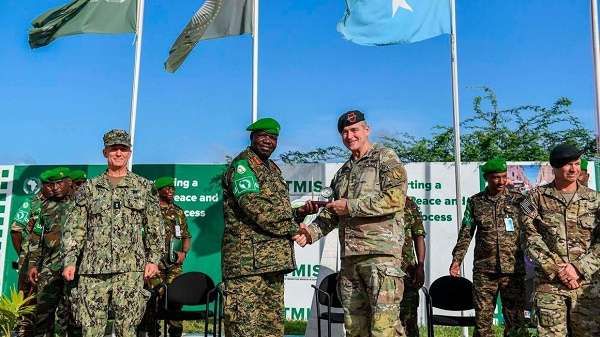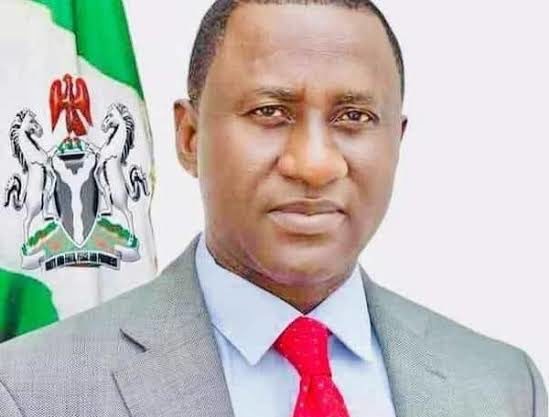East Africa braces for war on terror as Atmis exits

And that may signal both success and new challenges for a region that had tried to put out the Al Shabaab problem at the source. As per the scheduled drawdown, Atmis is expected to be fully out of Somalia by the end of 2024, leaving the obligation to guard installations and the people to Somali security forces.
On August 30, Atmis force commander Lt-Gen Sam Okiding was assessing the impact of the programme ahead of the exit of the second batch of soldiers due end of this month. His conclusion is that none of the troop-contributing countries can afford to sit on their hands yet.
The biggest task at hand, even as the troop numbers reduce, he argued, is to support the Somali forces to maintain the gains of the African Union force. This will ensure there is stability and will secure 80 percent of the country’s territory that the peacekeepers have liberated.
“Our goal, as Atmis and all stakeholders in this mission, is to see a more secure, stable and prosperous Somalia at peace with itself and the rest of the world,” said Lt-Gen Okiding during a media briefing in Mogadishu.
“One of our key roles is to make sure that we mentor the Somali security forces so that when we exit Somalia, there will be no security vacuum,” Okiding explained.
This month, some 3,000 troops will be leaving their bases in the capital Mogadishu and other strategic cities and cede up to nine forward operating bases – four of which are up for closure while another five, including those securing key government institutions like Parliament and State House, are to be handed over to Somali forces.
The EastAfrican has learnt that in phase two of the drawdown expected to conclude on September 30, Atmis will hand over forward operating bases that include State House, Parliament, Kismayo Old Airport, Dhusamareb and Bioxadale.
The peacekeeping force will also permanently close Salile, Burhashi, Regase and Qorilow bases, with the Somali National Army to fill the gap.
State House (Villa Somalia) and the federal parliament as well as other key security, political and diplomatic offices in Mogadishu are currently secured by Ugandan troops under Sector One of Atmis while strategic cities like Kismayo are under the Kenya Defence Forces contingent.
The idea of exiting may please critics of Atmis who for long argued that there had been little transition and capacity building to prepare Somali authorities.
This week, US-Africom Commander Michael Langley, speaking generally on Somalia’s counter-terrorism preparedness and President Hassan Sheikh Mohamud’s counter-terrorism response, told a media session he was cautiously optimistic of Somalia holding its fort.
“It’s not just the operations against Al Shabaab. It’s his whole of government operations of establishing his vision, reaching his vision,” Gen Langley told a virtual press conference from Zambia on Tuesday, ahead of the scheduled Senior Enlisted Leader Conference in Lusaka.
“He’s doing this by engagements, continuous engagements. So, what we don’t see a lot of times is him being able to continuously engage with the federal member states, and also engaging with Al Shabaab.
“And some members (of Al Shabaab) have put down their arms, have come back into the whole of government fold, as he calls it, into reaching Somalia’s vision as a nation. So yes, I’m cautiously optimistic in their operations and his whole-of-government approach.”
Optimism
President Mohamud, who has inspired volunteers to side with the Somali National Army against Al Shabaab, has said his country is entering the second phase of the war. This week, he told a group of army commanders on the battlefront to liken this war to that of independence against colonialists.
“Whether one battle is lost, or misinformation is spread, the war will continue,” said Mohamud.
“Despite the spread of false information, our military campaign against Al Shabaab will continue till we achieve a final victory, which is closer,” Mohamud had said earlier this month in an address to the nation, speaking from Dhusamareb, the capital of Galmudug State, 511km north of Mogadishu, where he has been operating from since August, symbolically bringing his presence to the battlefront. This seems to have inspired the troops.
But their success has been mixed. Last week, a senior intelligence official was assassinated, just after troops took back control of a key town in the South West state.
Mohamud has since appointed Gen. Ibrahim Sheikh Mohydin as the new army chief of general staff to replace Gen. Odowa Yusuf Raghe, and Gen Ahmed Adan Ali as the commander of the infantry division, replacing Gen. Mohamed Tahlil Bihi.
To turn the war against the extremists into a national objective, Mohamud hosted federal state leaders in a National Consultative Council (NCC) in August.
“The NCC collectively agreed to energise the preparation of the federal government and member states towards the liberation of Jubbaland, South West and the swathes of territory west of Shabelle River,” they said early in September in a joint communique.
The NCC is supposed to include all federal member states as well as the federal government. But Puntland, still bickering with Somalia, has been staying away. Other states include Hirshabelle, Galmudug, Jubbaland and South West.
And support of clans in Jubbaland and South West is lukewarm for the second phase of the offensive dubbed ‘Black Lion’. Some experts say Jubbaland and South West are important because they also directly affect neighbours who may want to be involved to secure their own borders.
“Beyond funding the fighting, international partners need to help Somalia stabilise liberated areas. Basic infrastructure, including resources for local governance, will build communities’ resistance to the Al Shabaab,” said Abdirasak Aden, a former permanent secretary in the Ministry of Information, now executive director, of Farsight Africa Research and Policy Studies, a local think-tank.
“Simple things like local courts have been absent, leading the militants to fill the void. Job creation, to keep youth from joining the terrorist ranks, are needed.”
Somalia is still under an arms embargo, however. To succeed post-Atmis, some neighbours like Kenya may have to change or upend their policy regarding Mogadishu. At one time, Nairobi supported a continual arms embargo. Somalia has called for a change and wants the UN Security Council to lift the embargo when it expires later this year.
Short of that, there is a risk that Al Shabaab could continue attacking anyone associated with the federal government, including neighbours and development partners.
Experts are also not convinced Somalia can go it alone, given recent setbacks by Somali forces manning FOBs such as the raid in July on Gherille, which the Kenya contingent of Atmis had just handed over.
In the same month, a suicide car bomb was reported on Welmarow, Jubaland, highlighting the ever-present risks.
“There seem to be doubts… given some of the recent setbacks in the offensive operations, which has created concerns about the risk of leaving a security vacuum that could be exploited by Al Shabaab,” reads a September 13 bulletin by Amani Africa, a think-tank based in Addis Ababa that tracks African Union organs and programmes.
“There is also a risk that Somali forces garrisoned in former AU operating bases might be particularly vulnerable to Al Shabaab attack,” wrote Paul D. Williams, professor of International Affairs at George Washington University, in his assessment of the impeding troop withdrawal.
Deal by neighbours
After the forthcoming drawdown of 3,000 troops, the AU force will be down to 14,626 soldiers, down from 17,626 that were left after the June 30 withdrawal. Over the period, the Somali National Army is expected to generate and increase by 12,375 combatants.
In June, the head of Atmis Mohammed El-Amine Souef told the UN Security Council that military offensives led by the Somali security forces have dislodged Al Shabaab from over 70 locations across Somalia.
There is a chance for neighbours to support Somalia, however. In February, Kenya, Ethiopia and Djibouti signed with Somalia a ‘frontiers agreement’, a deal that meant the neighbours had owned Somalia’s burden of counterterrorism on three fronts: to cut off financial channels to the extremist gangs, to put in place programmes to dissuade recruits to surrender and counter Al Shabaab ideology, and to support a military go at those who fight.
The budgets will have to be owned up by the individual countries, even though the agreement suggested the countries can mobilise donor support.
Amani Africa, however, suggests a local rebuild first, including strengthening the command structure and capacity of the Somali National Army.
Source: theeastafrican.co.ke





